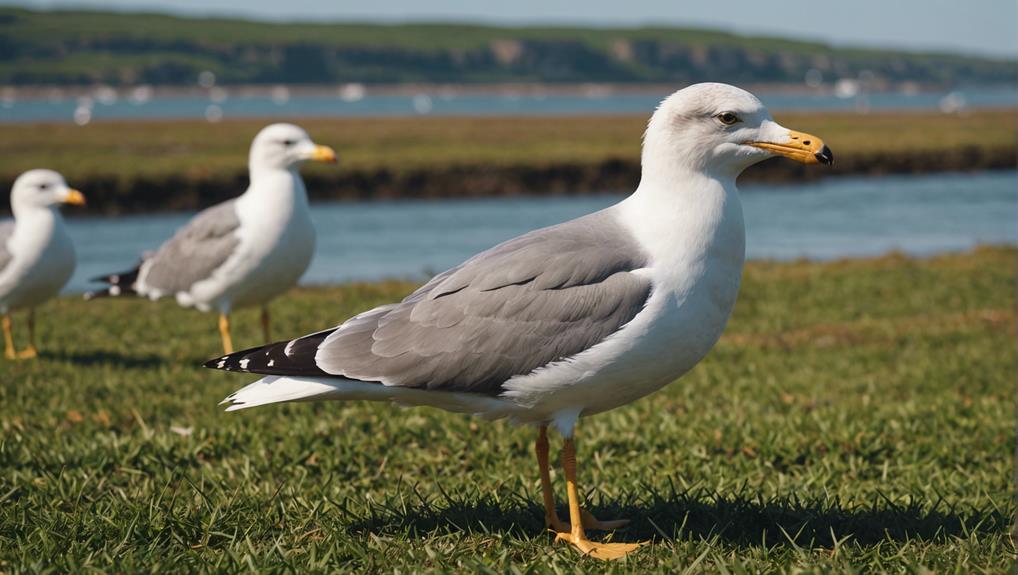To identify gulls, observe their size, shape, and color patterns. Large gulls, like the Great Black-backed Gull, have thick bills and pink legs. Smaller gulls, such as the Laughing Gull, display delicate features and dark gray mantles. Note bill color, ranging from bright yellow to darker hues, and leg color, which can be pink or yellow. Pay attention to wing patterns; some gulls have black wing tips, while others show white patches. Seasonal changes in plumage can also provide clues, with breeding seasons showing vibrant colors. To explore more nuances in identifying these fascinating birds, continue examining.
Key Features of Gulls
Identifying gulls relies heavily on observing key features such as size, shape, and color pattern. Each gull species exhibits a unique combination of these traits, making it crucial to focus on specific characteristics for accurate identification. Size and shape are primary indicators; large gulls generally possess thick bills and broad wings, while smaller species tend to have more delicate features.
The bill, a significant identifier, varies in thickness and shape among species. Observing the color and length of the legs also provides critical clues, as different gulls display distinct leg colors, ranging from pink to yellow. The back color, head pattern, and wing pattern are additional traits that distinguish one species from another. For example, some gulls may have a black head or a speckled pattern in certain seasons, which changes as they mature.
Practicing by scanning flocks and focusing on these unique characteristics helps in honing the skill of identifying gulls. By paying close attention to these details, bird watchers can achieve accurate identification and appreciate the diversity within the gull species. This methodical approach ensures a deeper understanding and enjoyment of these fascinating birds.
Common Gull Species
Among the diverse family of gulls, several species are frequently encountered across different coastal regions. Herring Gulls, for instance, are large and widespread across North America. They are easily recognizable by their black wing tips and yellow legs. Often found scavenging near coastal areas, they are a common sight for those living near the sea.
Another notable species is the Great Black-backed Gull, the largest gull found on the north Atlantic coast. These imposing birds have a nearly black mantle, black wing tips, and pink legs, making them a striking presence along the shoreline. Their size and distinctive coloration set them apart from other gull species.
The Glaucous-winged Gull is primarily found on the Pacific coast. This species has a light gray mantle with slightly darker wing tips, making it a bit more subtle in appearance compared to its more boldly marked relatives. Their habitat along the Pacific coast provides a unique viewing opportunity for bird enthusiasts in that region.
Laughing Gulls, medium-sized and known for their distinct vocalizations, inhabit the Atlantic and Gulf coasts. Their dark gray mantle, black head in summer, black wing tips, and deep red bill create a vivid contrast, making them easily identifiable even from a distance.
Distinctive Markings

Understanding the distinctive markings of gulls is crucial for accurate species identification. Gulls exhibit a variety of features, such as leg color, wing pattern, bill color, back color, and head pattern, which can aid in distinguishing between common species.
One of the primary indicators for gull identification is leg color. Large gulls often have pink legs, while medium-sized gulls tend to have yellow legs. Smaller gulls may display black or red legs. Observing the wing pattern is also significant; look for unique characteristics like black wing tips or white patches.
Bill color is another key feature. For instance, some gulls have bright yellow bills with red spots, while others may have darker hues. The back color can range from light gray to almost black, providing another clue in identifying the species.
Moreover, the head pattern varies among gulls, with some species having pure white heads and others exhibiting streaked or mottled patterns during different seasons.
Practicing these identification techniques by scanning gull flocks can help you recognize common species in your area. By focusing on these distinctive markings, bird watchers can improve their ability to identify gulls accurately and enjoy the diversity these birds offer.
Seasonal Variations
Seasonal variations in gull plumage greatly impact their appearance and can complicate species identification. During the breeding season, gulls often display more vibrant colors and distinct patterns, which are important for attracting mates. These changes can include brighter beaks, legs, and more pronounced markings on their bodies.
In contrast, during the non-breeding season, their plumage becomes more subdued, with muted tones that make them less distinguishable.
Understanding these seasonal variations is vital for accurate identification throughout the year. Gulls also undergo molting processes that further affect their appearance. Molting typically involves the shedding and regrowth of feathers, leading to temporary phases where their plumage may appear patchy or inconsistent.
Observing these changes can provide significant insights into their life cycle and behavior.
Rare Gull Sightings

While mostly seasonal variations in gull plumage offer a fascinating glimpse into their life cycles, the appearance of rare gull species adds an extra layer of intrigue to avian observation. Among the notable rare gull sightings, Heermann's Gulls stand out for their distinctive characteristics. Unique in California, these gulls feature a dark gray back, a striking white head, and a pronounced red orbital ring around their eyes. Breeding mainly on Isla Rasa near Baja, California, Heermann's Gulls are a sight to behold for any avid birdwatcher.
These gulls employ a kleptoparasitism feeding strategy, which means they often steal food from other birds. This behavior is particularly interesting to observe, as it showcases their adaptability and resourcefulness. Heermann's Gulls are not just fascinating due to their appearance and behavior but also because they are vulnerable to climate change. Changes in their breeding grounds and food availability pose significant threats to their population.
Spotting a Heermann's Gull can be a rare and rewarding experience, adding a unique highlight to any birding adventure. Their presence in California, characterized by their dark gray back and red orbital ring, makes them a cherished find for bird enthusiasts.
Conservation Efforts
How can we effectively safeguard gull populations against the myriad threats they face in their natural habitats? Conservation efforts for gulls are critical to ensuring the survival of these species. Protecting their habitats, such as coastal areas and nesting sites, is a fundamental aspect of conservation. Monitoring gull populations helps assess their numbers and distribution, guiding conservation strategies.
Conservation organizations work tirelessly to mitigate threats such as pollution, habitat destruction, and human disturbance. Public education and awareness campaigns play a significant role in promoting responsible behavior around gulls and their habitats. These efforts aim to foster a culture of coexistence and respect for wildlife.
Collaboration is key to successful conservation. Researchers, government agencies, and local communities often join forces to implement effective strategies. This unified approach optimizes resources and expertise, enhancing the impact of conservation initiatives.
- Protecting habitats like coastal areas and nesting sites
- Monitoring populations to assess numbers and distribution
- Reducing threats such as pollution and human disturbance
- Promoting public education and awareness
Further Resources

For those interested in deepening their knowledge about gulls, numerous resources are available that offer thorough information and practical identification tips. One standout resource is the field guide 'Gulls Simplified' by Pete Dunne and Kevin Karlson. This guide focuses on common species, such as the Western Gull and California Gulls, and simplifies the identification process using clear photos and user-friendly text. By emphasizing key structural features and expected species in specific locations, it aids birders in identifying both common and outlier gulls with ease.
Another valuable resource is the Cornell Lab, which provides extensive online databases and tools for bird identification, including gulls of the Laridae family.
For those interested in the conservation and broader ecological roles of gulls, the Audubon Society offers detailed articles and field guides, including information on the Lesser black-backed gull and other notable species.
These resources collectively improve understanding and appreciation of gulls, making it easier to identify a flock of gulls in diverse settings. Through the comparative approach and practical tips offered in 'Gulls Simplified,' bird enthusiasts can gain confidence and proficiency in gull identification, enriching their bird-watching experiences.
Frequently Asked Questions
How Can You Tell Seagulls Apart?
To tell seagulls apart, observe key features like size, shape, and color patterns.
Notice differences in back color, head markings, and wing patterns.
Check their leg color—large gulls often have pink legs, while medium ones usually have yellow. Also, small gulls can have black or red legs.
Since gulls' appearances change with maturity, consider their plumage variations to identify them accurately.
Practice and attention to detail are crucial.
Is There a Difference Between Gulls and Seagulls?
There is no scientific difference between gulls and seagulls; they are the same bird species.
The term 'seagull' is a common, non-scientific name used to describe gulls that live near the sea.
Gulls are diverse seabirds within the Laridae family, found in different habitats beyond coastlines.
While they differ in size, color, and behavior, all gulls share intelligence and adaptability, making them intriguing subjects for observation and study.
Why Are Gulls Difficult to Identify?
Gulls are difficult to identify due to their similar appearances, subtle differences in plumage, and changes with maturity. The challenge intensifies with hybridization between species and individual variations.
Furthermore, maturity-specific plumages make distinguishing between species tough. Often, minor deviations in size, color, and markings are vital for accurate identification.
Gull-watching typically occurs in harsh winter conditions, further complicating the task for bird enthusiasts and researchers.
How Do You Identify Gulls and Terns?
To identify gulls and terns, observe their size, shape, and color patterns. Focus on specific features like bill shape, leg color, back color, and wing patterns.
Note that these birds change plumage as they mature, so consider maturity and seasonal variations.
Practice scanning flocks, concentrating on key structural features.
Familiarize yourself with common species in your area to improve your birdwatching skills and make accurate identifications.

